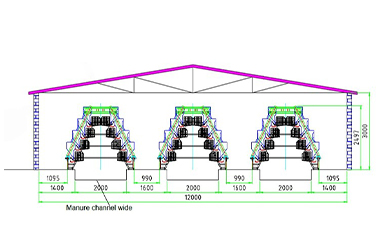wire chicken cage
Oct . 10, 2024 11:49 Back to list
wire chicken cage
The Wire Chicken Cage A Closer Look
In the realm of poultry farming, one of the most essential elements is the housing used for chickens. Among various options available, wire chicken cages stand out for their practicality, efficiency, and ease of maintenance. This article delves into the advantages and considerations of using wire chicken cages, helping both seasoned farmers and newcomers to make informed decisions.
Design and Structure
Wire chicken cages are typically constructed from galvanized steel or other durable materials, ensuring longevity and resistance to weather conditions. The cages can come in various sizes and designs, ranging from single-unit setups for backyard poultry enthusiasts to expansive multi-tier systems used in commercial operations. The wire mesh allows for ample ventilation while also providing visibility, essential factors for the well-being of the chickens.
Advantages of Wire Chicken Cages
1. Space Efficiency One of the most significant benefits of wire chicken cages is their space efficiency. Cages can be stacked vertically or arranged side-by-side, allowing farmers to maximize their available area. This is especially beneficial for larger farms where the density of birds can impact productivity.
2. Easy Cleaning The design of wire chicken cages often incorporates a removable tray or sloped floor, making it easy to collect manure and waste. Regular cleaning is essential to maintain the health of the birds and the hygiene of the environment. The simplicity of cleaning wire cages saves farmers time and effort, allowing them to focus on other important aspects of poultry care.
3. Health Monitoring With wire cages, it is easier to monitor the health and behavior of individual chickens. The visibility provided by the wire design aids in the early detection of illness or abnormal behavior, enabling timely intervention. Healthy chickens are crucial for maintaining productivity levels.
wire chicken cage

4. Pest Control Wire cages are also advantageous in terms of pest control. The elevated design and tight mesh prevent rodents and other animals from accessing the chickens, reducing the risk of disease transmission and ensuring a healthier flock.
5. Temperature Regulation The open design of wire cages facilitates good air circulation, helping to regulate temperature and reduce the risk of heat stress in warm climates. This is an essential factor, as extreme temperatures can adversely affect the health and egg production rates of chickens.
Considerations When Using Wire Cages
While wire chicken cages come with many benefits, there are a few considerations to keep in mind. The wire can sometimes cause injuries if chickens are not properly managed. Sharp edges or improper spacing can lead to trapped feathers or even injury. Therefore, it’s crucial to invest in high-quality cages and regularly inspect them for any signs of wear or damage.
Furthermore, chickens housed in wire cages may have limited access to natural behaviors such as foraging and dust bathing. To mitigate this, farmers should make an effort to provide enrichment activities, such as hanging vegetables or providing dust baths, ensuring that the birds can express natural behaviors even within a confined space.
Conclusion
Wire chicken cages represent a valuable method of poultry housing that aligns with the practical needs of both small-scale and commercial chicken farmers. While providing numerous advantages, it’s essential to approach their use thoughtfully, considering the animals' well-being and implementing necessary enrichment strategies. By combining efficient design with mindful management, wire chicken cages can contribute significantly to successful poultry farming, ensuring healthy birds and a thriving agricultural business.
-
Hot Sale 24 & 18 Door Rabbit Cages - Premium Breeding Solutions
NewsJul.25,2025
-
Automatic Feeding Line System Pan Feeder Nipple Drinker - Anping County Yize Metal Products Co., Ltd.
NewsJul.21,2025
-
Automatic Feeding Line System Pan Feeder Nipple Drinker - Anping County Yize Metal Products Co., Ltd.
NewsJul.21,2025
-
Automatic Feeding Line System - Anping Yize | Precision & Nipple
NewsJul.21,2025
-
Automatic Feeding Line System - Anping Yize | Precision & Nipple
NewsJul.21,2025
-
Automatic Feeding Line System-Anping County Yize Metal Products Co., Ltd.|Efficient Feed Distribution&Customized Animal Farming Solutions
NewsJul.21,2025






